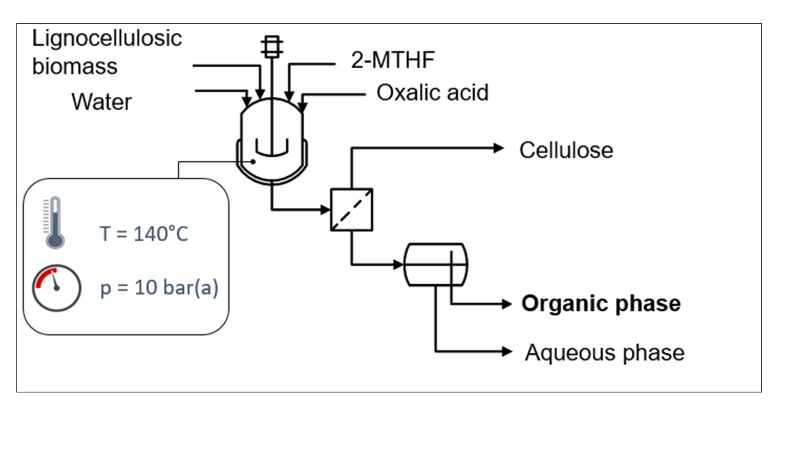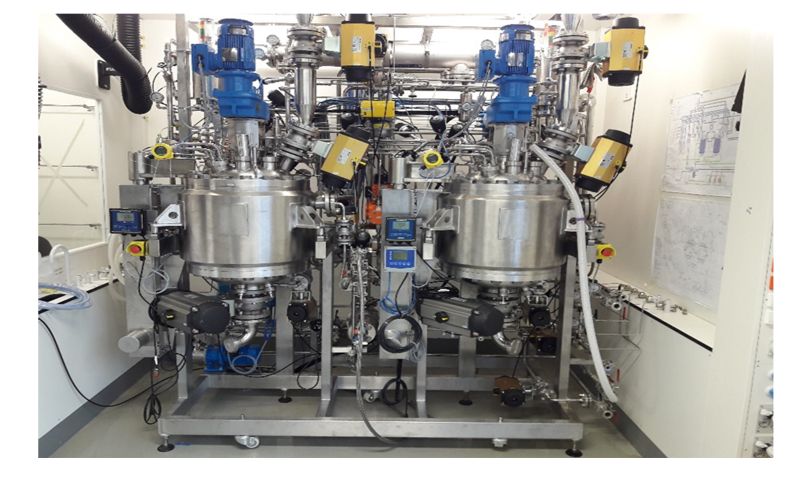One key objective of the project was to identify a new strategy for lignin separation. Research based on laboratory experiments and process simulations was performed in order to evaluate different process options for the separation tasks, to increase the technology readiness level of the process and to enable the realization in the biorefinery pilot plant of the Aachener Verfahrenstechnik (AVT) at the RWTH Aachen University. Fractionation of biomass can be realized efficiently with the OrganoCat process, which was recently developed at the RWTH Aachen University (Fig. 1). It uses a biphasic solvent system consisting of water and the organic solvent 2-methyltetrahudrofurane (2-MTHF) in combination with a bio-based organic acid, e.g. oxalic acid, to obtain the three biopolymers cellulose, hemicellulose and lignin in three separate phases at the end of the fractionation step. Lignin is extracted insitu into the organic liquid phase, whereas depolymerized polysaccharides remain in the aqueous liquid phase. Cellulose is separated from the liquids by filtration. Separation of lignin from the organic solvent 2-MTHF is required in order to enable solvent recycling and further processing of the product lignin. However, the most obvious approach – solvent recovery by evaporation of 2-MTHF – is not feasible in technical scale as complete evaporation of 2-MTHF leads to the generation of lignin incrustations on evaporator surfaces, which impede further evaporation of the solvent. For this reason, in the project AP³, a new concept for lignin separation based on antisolvent precipitation was successfully developed.

In a first step, an antisolvent screening was conducted to identify substances that precipitate lignin from 2-MTHF solutions. Requirements for suitable antisolvents were low solubility for lignin, miscibility with 2-MTHF and simple recovery from the organic phase by rectification. As high lignin precipitation yields and efficient antisolvent recovery were achieved using n-pentane, it was selected for the antisolvent precipitation process. Lignin solubility in the ternary system – lignin, 2-MTHF and n-pentane – was investigated in detail in order to determine a suitable antisolvent to organic phase ratio in the precipitation process. Based on the experimentally determined solubility data and process simulations using the software Aspen Plus, an energetically favourable process concept was developed. The process concept consists of solvent pre-evaporation, lignin precipitation using n-pentane as antisolvent and antisolvent recovery by rectification (Fig. 2). This downstream process was performed successfully in laboratory scale and led to solid lignin that could be separated from the organic phase by filtration. The OrganoCat pulping process was then upscaled into the biorefinery pilot plant of the Aachener Verfahrenstechnik in a 50 L reactor (Fig. 3). 2.5 kg of beech wood were successfully fractionated into the three biopolymers using 25 L of water, 25 L of 2-MTHF and 15 g of oxalic acid.


After keeping the reactor temperature at 140 °C for 3 hours, the product phases were separated from each other by filtration and decantation. The production of larger amounts of the organic phase with OrganoCat lignin in the biorefinery pilot plant also enabled the testing of the developed antisolvent precipitation process for lignin separation. Although lignin was successfully precipitated upon the addition of n-pentane, the realization of the process in larger scale revealed some difficulties: depending on the applied process conditions, transformation of the precipitated lignin particles was observed, which led to soft lignin with poor filtration properties. As the developed process is still considered a promising concept for the separation of lignin from the organic product phase, the influence of the selected process conditions on the properties of the lignin particles will be investigated in the future.
Prof. W. Leitner
Institute for Technical and Macromolecular Chemistry
RWTH Aachen University
Prof. U. Schurr
Dr. Philipp M. Grande
Institute for Bio- and Geosciences: Plant Sciences
Forschungszentrum Jülich GmbH
Prof. A. Jupke
T. Maßmann M.Sc
AVT – Fluid Process Engineering
RWTH Aachen University
Prof. A. Mitsos
Dr. J. Viell
AVT – Process Systems Engineering
RWTH Aachen University